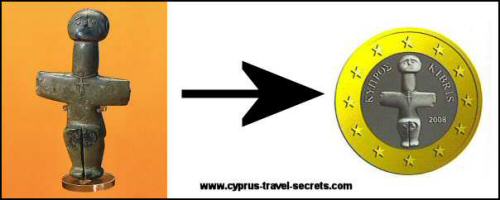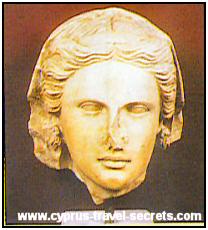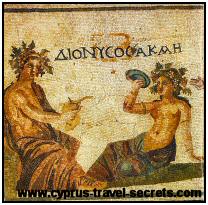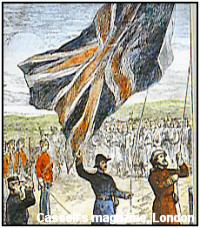Discover the riches in Cyprus history
Our potted version of Cyprus history shows how Cyprus rose from the sea bed to become the prime catch for thousands of invaders from both East and West.

Cyprus history is as rich and colourful as the deep blue waters of the Mediterranean and as juicy as the mouthwatering specialities to be found on the island.
To fully appreciate it, you need to immerse yourself in one of the many books about the history of Cyprus. We'll try to whet your appetite with our potted version of Cypriot history.
History Cyprus
- 90 million years ago, Cyprus lay beneath the ocean.
- When the African and Eurasian plates collided, the mountains that were to become the Troodos and Kyrenian ranges rose from the ocean depths.
- Man inhabited the island from around 7000 BC.
- By 3000 BC (the Bronze Age), Cyprus headed the production of copper from where it probably gets its name - this made the island a magnet for traders from the east and the west.
-

More Cyprus History
From 1400 BC, Mycenian Greeks colonised Cyprus and founded new cities, although the island was alternately controlled by the Egyptians and Assyrians.
- At the crossroads between East and West, the island became a natural stopping point for imperialists crossing the major continents in search of new lands to conquer - the scene was set for a long period of colonisation and acquiesence to a long list of invaders, as Cyprus history shows.
- In 540 BC Cyprus became part of the Persian Empire when the Persians conquered Egypt with ease.
- 50 years later, the Greek Ionians tried to conquer the Persians and, whilst steeped in Greek culture following previous colonisation, Cyprus fought with the Persians against the Greeks - the Persians won!
- By 325 BC, however, Persian rule had succumbed to a much greater power, that of the young Macedonian king,
Alexander the Great.
Cyprus was absorbed into his vast empire to be fought over by Alexander's 3 main generals.
- Ptolemy, the best general, won and the island became a province of Egypt once again.
- More bloody change came in 58 BC when the Romans arrived and annexed Cyprus to Rome.
-

Under the Romans, a relatively peaceful period of 250 years in Cyprus history ensued with many fine buildings and monuments being constructed, such as the Tombs of the Kings at Paphos, the seat of Roman government on the island.
- From 330-1191 AD, Cyprus entered a golden period of Byzantine rule, governed by the Eastern Roman Empire known as Byzantium with its capital of Constantinople.
- This golden period was, however, marked by centuries of bloody warfare as invading Arabs tried to
conquer Cyprus.
By 650 AD, the island was split between Byzantines and Arabs and many Cypriots had fled inland away from the coastal cities built during the reign of the Romans.
- In 965 AD, the Byzantines fought back and left their legacy via frescoes in monasteries and churches such as those found in the 10 UNESCO listed churches in the Troodos mountains.
- 200 years later, Issac Komnenos, a tyrannical member of Byzantium's imperial family, seized Cyprus and declared the island independent.
- He was ceremonially dumped a few years later by Richard the Lionheart who invaded the island after
Komnenos was rude to his fiancée.
The Cypriots rebelled against Richard when he tried to impose Catholicism on them.
- After trying to sell the island to an elite order of monks, Richard finally handed it over to Guy de Lusignan who brought the Catholic faith to the island anyway from France, suppressing the Christian Orthodox faith.
- The Lusignans ruled until 1489 when Queen Catherina Cornaro ceded Cyprus to Venice.
- The Venetians ruled the Cypriots with brutal force, imposed punitive taxes and fortified the island against the Ottomans who conquered Constantinople in 1453.
- As expected, the Turks invaded and, despite the fortress walls around Nicosia, the Venetians fell
and the Turks slaughtered 20,000 people within the city walls.
The city of Ammochostos was less easy to capture after a brave defence by Marc Antonio Bragadin. His 8000 strong army managed to keep 200,000 Turkish troops at bay for a year before he was flayed alive and all his troops slaughtered. A bloody time in the history of Cyprus indeed.
- Under the Ottoman Empire, The Catholic Church was abolished and Orthodoxy returned. Taxes were heavy and harvests poor leading to a dramatic fall in the island's population from 150,000 to only 25,000 people in 1641.
- When Greece launched its campaign for independence in 1821, several Cypriot Greeks were executed to stop Cyprus from joining the Greeks and Turkey managed to hold on to Cyprus.
- But by 1878, Britain was the key force in the region and took administrative control of Cyprus after the Ottomans ceded the island in return for subsidies and assistance against Russia.
- British money enabled the construction of roads and bridges and started a reafforestation programme to replace the forests in The Troodos and Kyrenian mountains.
-

Cyprus was annexed to Britain in 1914 as the First World war broke out and Turkey sided with Germany.
During the war, Cyprus was offered to Greece on condition that they joined the British, but, as the history of Cyprus shows, Greece refused.
- Turkey relinquished any rights to the island under the Treaty of Lausanne in 1923.
- After fighting with the British in World War Two, Cyprus hoped that the British would agree to a union with Greece
known as Enosis.
Britain refused and the Cypriots took their case to the UN. The writing was on the wall but Britain, apparently, ignored it.
- Whilst Britain consulted with Greece and Turkey over the island's future, the Greek Cypriots tried to play their part
through George Grivas who formed the EOKA (Ethniki Organosis Kyprion Agoniston = National
Organisation of Cypriot Fighters) to wage a guerilla war against the British.
From 1955 many innocent people were caught in the crossfire as so poignantly discussed by Laurence Durrell. in his book Bitter Lemons of Cyprus.
- In 1960, Cyprus became a Republic after a resolution at the UN with the big three having power as "guarantors" - the ability to intervene should the island's independence be threatened. Britain retained two military bases on the island and, in a legacy of Cyprus history, those bases are still here.
- President Archbishop Makarios tried to amend the unworkable constitution in 1963 - unworkable as the constitution
gave power of veto to both the 15 strong Turkish minority aswell as the 35 strong Greek majority meaning no decisions were
ever made!
But this angered the Turks who withdrew from the Cabinet and Turkey threatened to invade.
- A UN peace keeping force succeeded in keeping the peace until the pro-Enosis EOKA tried to overthrow
Archbishop Makarios in 1974.
Turkey exerted its power as a "guarantor", invaded under the pretext of safeguarding the island's independence and has controlled a third of the island in the North ever since.
- Turkey is the only country to recognise the TRNC or Turkish Republic of Northern Cyprus and refuses
to withdraw its troops.
The Cyprus history problem of a divided island therefore still exists today.
- The Greek Republic of Cyprus has prospered and is now a thriving modern country whilst the North of the island remains poor with a limited infrastructure.
- We hope that a solution to the Cyprus problem will one day be found now that Cyprus has joined the EU.

If you would like to read more about Cyprus history, we recommend the excellent "Cyprus Is & Cyprus Was" sections in the AA book Explorer Cyprus.
That's all from our Cyprus history lesson.
Related Pages
| SITEMAP | CONTACT | ABOUT| SITE POLICIES| FINANCIAL FREEDOM
VILLAS| HOTELS| ONLINE TAXI BOOKINGS| CHEAP FLIGHTS| CAR HIRE
Return from Cyprus History to About Cyprus







New! Comments
Have your say about what you just read! Leave me a comment in the box below.